How to Write a Guest Post Pitch That Converts: 5 Proven Steps

Wondering how to write a pitch that doesn’t instantly get deleted and marked as spam?
You aren’t alone.
Getting your guest post accepted is becoming harder with each passing day.
Websites get hundreds of pitches every week and it seems like you have a 1% chance of getting noticed.
Is it pointless to keep pitching?
Good news—it isn’t.
There’s a proven process you can use to DRASTICALLY increase your chances of having your article published.
My team and I have refined it over the past 5 years with over 3,000 emails, and I’m going to show you how to implement it step-by-step.
I’m not guaranteeing you a published article by following this process, but I can guarantee your pitches will stand out.
I’ve personally used this exact formula to land guest posts on sites like SEMRush, WordStream, and MarketingProfs.
5 Steps to Writing a Killer Pitch
Determine concrete, trackable goals.Find the best person to contact.
Figure out how you'll provide value.
Write your pitch with proven copywriting principles.
Track your campaign and send follow-ups.
Step 1. Determine concrete, trackable goals.
I know you just rolled your eyes as you read this first step, it’s ok.
But that doesn’t change the fact that you need to know what you want before you try to get it.
If you start an outreach campaign and you don’t have a clear definition of success, you won’t have any way of knowing what worked and whether you should keep trying.
I’ve seen so many campaigns die due to a lack of clear goals...
So, how do you prevent yours from ending up in the graveyard?
Start by clearly defining:
- How many placements you want
- Where you want your placements
- How many emails you’ll send at a time
This last one is critical…and people often overlook it.
I recommend sending outreach emails in small groups with a slight delay between them.
The specific number per group depends on your situation and how many placements you’re looking for, but I usually stick to 25-50.
Why?
Because this helps you quickly get data on what subject lines, article ideas, and email templates work best.
If you just crank out 100s of emails every week without paying close attention, you’ll end up sending tons of unoptimized emails and risk getting put on sites’ blacklists.
Even the slightest hint of a templated email can sabotage you.
So, set clear goals and structure your outreach campaign like a science experiment before you send your first email.
Step 2. Find the best person to contact.
Half the battle with getting a pitch accepted isn’t actually about the email itself...
It’s finding the right person to contact.
Because even the best pitch can collect dust in an inbox somewhere if sent to:
- A support email
- A former employee’s email
- Someone who doesn’t work in editorial/content
The key is going directly to a decision-maker.
You don’t necessarily have to contact the Editor-In-Chief or CEO, but you definitely want to send your pitch to someone with the power to accept it.
Otherwise, your pitch can get lost in the shuffle as it gets passed from person to person.
How to Find People with Power
Usually, you can figure out who to contact with some good old-fashioned web sleuthing.
I recommend following this rough process:
- Look on a site’s “team”, “about”, or “write for us” pages to see if there’s an obvious contact (an Editorial Director, CEO, Marketing Director, etc.)
- Do Google searches like “[POSITION] at [COMPANY]” (example: Editorial Director at HuffPost or Head of Marketing at Hunter.io)
- Do similar searches on LinkedIn
- Do Google searches like “editorial contacts at [COMPANY]” for bigger sites to see if they have a page somewhere with everyone’s name and email
Usually, you will find a great contact by Step 2.
How to Find Their Email Address
Hunter makes this easy.
Simply install the Chrome extension and head to the website you’re pitching.
Then, click the extension to see all the emails Hunter found for that site.
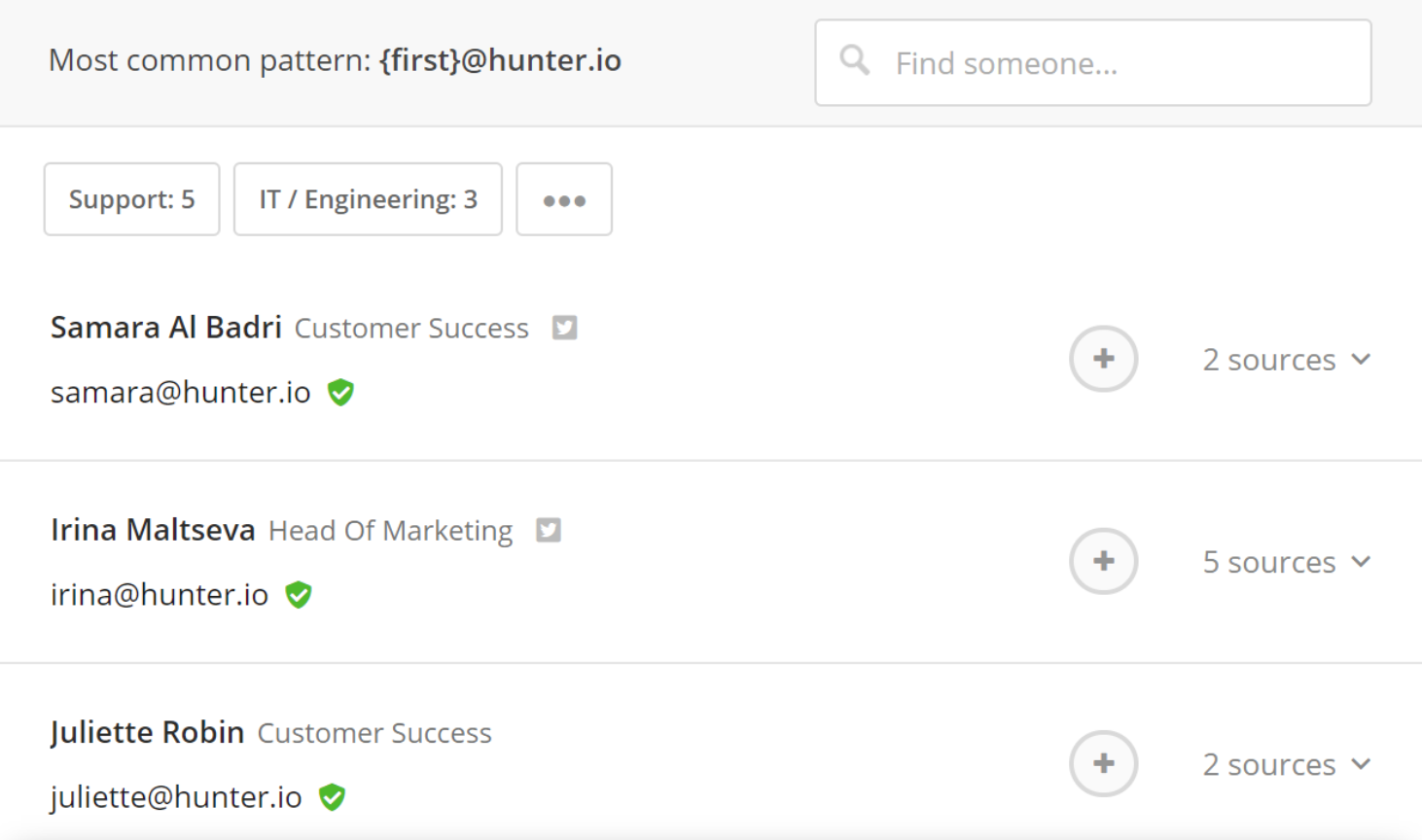
If you don’t see your contact’s email address, you can also search their name right within the extension (you can also do this with the Email Finder).
You can also use the Email Verifier to make sure the email is deliverable before you spend your precious time writing it (highly recommended).
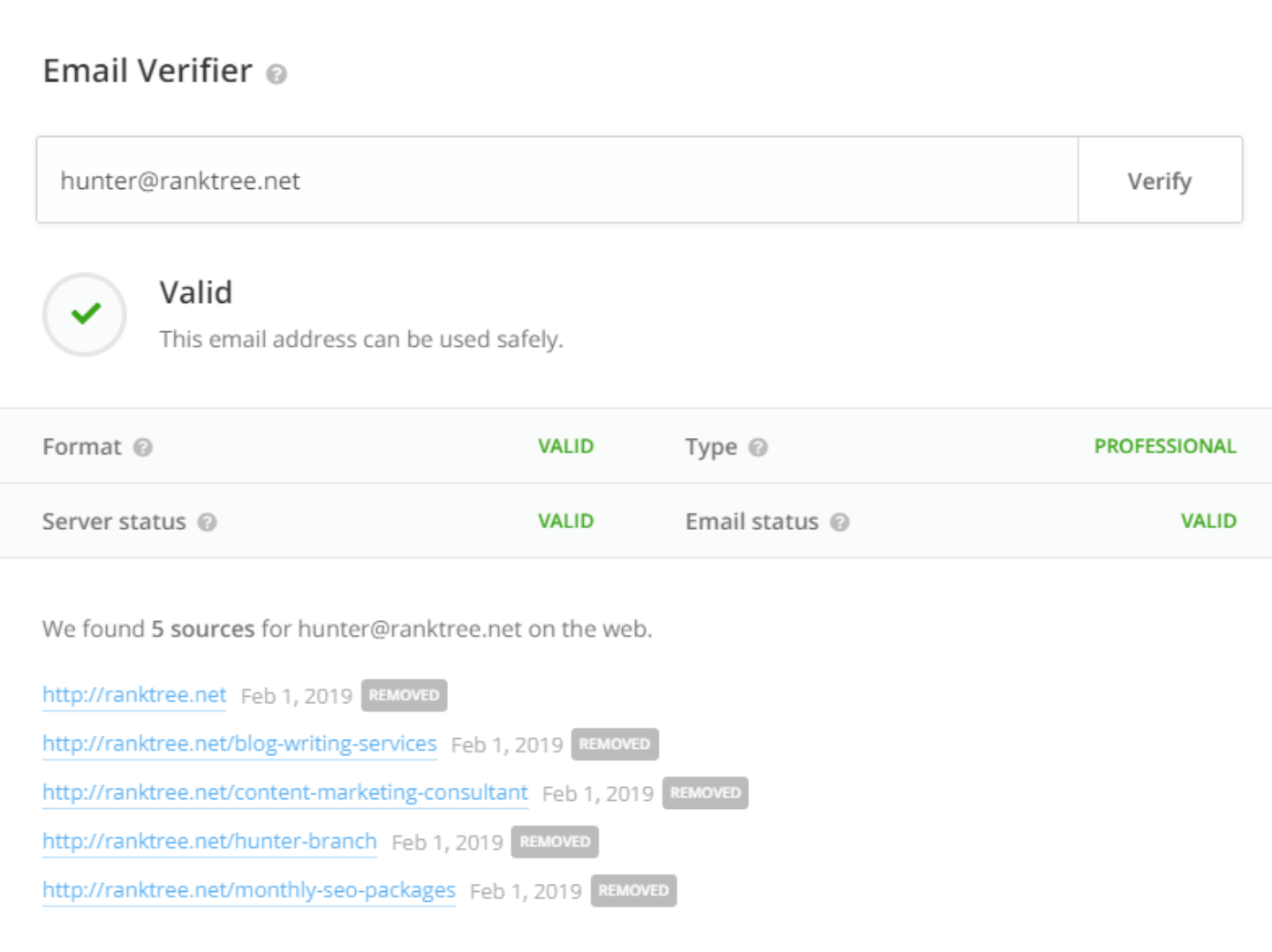
I’ve used Hunter to find emails for the past 4+ years and I haven’t found a better tool.
...Not to mention their name is super cool. ;)
Additional read: 8 Ways to Find Someone’s Email Address
Step 3. Figure out how you’ll provide value.
At this point in the process, most people go straight to reaching out to their target sites with a template since they have a contact.
Don’t make this mistake!
Before you even think about writing your pitch you need to figure out how you’ll give them value.
Because at the end of the day your pitch is simply an exchange of value.
If you can help them in some way, they’ll accept your pitch.
If not, they won’t.
It sounds harsh but it makes sense when you think about it…
These sites are businesses. They get 100s of pitches every day, and it only makes sense for them to select the most valuable ones.
But luckily, you can use this to your advantage and write a pitch that immediately gets their attention.
Ways You Can Provide Value
The first step in figuring out how to provide value is simply identifying a few obvious goals your target sites have.
This requires poking around their site, reading their content, and using tools like Ahrefs to see what keywords they’re ranking for.
Every site obviously wants more traffic, leads, and sales, but the goal is to identify specific initiatives.
Have they been producing content around a specific topic lately?
Are they clearly going after certain keywords?
Have they hosted a lot of guest writers recently? Any similarities among them?
What kind of marketing campaigns are they running via social media, email, etc.?
This context will help you craft an incredibly compelling pitch.
From a big-picture perspective, here are the 3 most valuable offers you can explore (based on our experimentation):
- Offer to promote them to your audience for free (via featuring an article from them, promoting their content, telling them you’ll send your audience to the article you’re pitching if it’s accepted, etc.)
- Offer them free access to a product or service (could be a course, membership site, ebook, etc.)
- Write an article that is so valuable that you wish it was on your site instead (you could help them rank in Google for a target keyword, provide exclusive data, write something you know they’ve been looking for, etc.)
I recommend doing a combination of #3 and either #1 or #2.
The key is creating a custom value add for each site you pitch to. The bigger the site, the better your offer should be.
Step 4. Write your pitch with proven copywriting principles.
Now, it’s time to actually write this thing.
There are four main things you’ll have to accomplish with your email to get a “yes”:
- Write an attention-grabbing subject line
- Write an attention-grabbing opening (and keep the prospect’s attention throughout)
- Prove you’re a real person who really follows their site
- Sell your prospect on your article (and the value you can give them)
This is where copywriting skills come into play.
But don’t fret…
You don’t have to be a master copywriter. You just have to know enough about persuasion to be dangerous. :)
And I’m going to show you exactly what I recommend focusing on.
Part 1. How to Write Attention-Grabbing Subject Lines
The #1 goal with your subject line is getting someone to open your email.
Not rocket science.
And the #1 way I’ve found to do that with pitch emails is by communicating your authority (based on Robert Cialdini’s book, Influence).
In essence, this means writing a subject line that convinces the recipient that you’re someone worth listening to.
How?
I like to follow this rough format:
[VALUABLE TOPIC] article idea for [SITE] from [SOMEONE FEATURED IN X PUBLICATION / YOUR TITLE]
Here’s an example:
If I wanted to pitch a site like Search Engine Journal on a new case study I wrote, I might use a subject line like this…
Exclusive link building case study idea for SEJ from someone featured in SEMRush
Don’t have a notable article to reference yet?
No problem.
In that case, I recommend using your title to display your authority.
Carrying the example from above, here’s another subject line I could use:
Exclusive link building case study idea for SEJ from an agency founder
The idea is alluding to how valuable your content could be for them and why you’re the best person to create it.
Additional read: 89 Effective Cold Email Subject Lines & How to Craft Them
Part 2. How to Write an Attention-Grabbing Opening
The opening is all about carrying the momentum from the subject line, further establishing your authority, and alluding to your content’s value.
I recommend accomplishing this through a few sentences:
1. The “who am I” sentences.
Directly after your greeting, these simple lines continue building your authority through your title.
For example…
I usually say something like this in outreach emails:
Hey [Name],
My name is Hunter and I’m the founder of Rank Tree—a content marketing agency for personal brands that has grown blogs that fuel 7-figure businesses.
The area right after the dash is hugely important.
It’s your place to indirectly (but powerfully) say to your recipient, “Here’s who I am and why you need to keep reading this email.”
Try to incorporate a specific achievement, result, or place you’ve been featured that would catch their attention.
Next, you want to tell them why you’re reaching out and mention a very specific piece of content you like (that they created recently) and why.
Don’t lie—take time to actually research the site and read their content. Your compliments need to be authentic.
Here’s an example:
I’m reaching out because I recently [READ A CERTAIN ARTICLE] and [REASON YOU LIKED IT AND SPECIFIC COMPLIMENT].
The more specific details you can include, the better.
2. The “how I’ll help you” sentence.
The goal of the next sentence is quickly telling your prospect why you’re emailing them, and more importantly, why they should care.
In our case, it’s because you have an incredible article idea for them—and you’ll sell them on that here.
You have a few options—you can offer to write:
- An SEO-driven post for their site based on keywords they want to rank for (but aren’t yet)
- A case study, experiment, or summary of exclusive data that’s relevant to their audience (“exclusive” meaning you collected the data and you’re only giving it to them).
- An article about a topic everyone wants to read about but no one is talking about (usually, this will be a topic based on your expertise — for example, I wrote a post for SEMRush about protecting your #1 ranking in Google because no one was talking about it and everyone wants it).
- A story on a specific topic you know they’ve been wanting to write about but haven’t yet (this usually requires a ton of digging).
Pick a unique angle for each site you reach out to.
When it comes to pitching the content idea you’ve landed on, here’s the structure I recommend:
That article made me think you might be interested in an article I’m writing on [SUMMARY OF CONTENT] that [SPECIFIC BENEFITS] based on [YOUR RESULTS OR SPECIFIC EXPERIENCE].
I’d love to write it for [SITE] if that’s of any interest!
Here’s an example I’ve used (that got accepted):
...It’s an exclusive guide to protecting your #1 ranking in Google that shows you 3 proven steps to follow based on my 5+ years of experience ranking sites.
Part 3. How to Write Your Closing Value Statement
At this point, your pitch should already be intriguing to them because your article idea is a home run—here’s where you put the icing on the cake.
I’ve found that offering something a little extra in your conclusion drastically increases your conversion rate.
This extra offer can be anything you think they’d find valuable.
Some ideas from our testing:
- Free access to one of your courses that they can giveaway to their audience (and one for them as well)
- Offering to build links to your post if they accept it
- Offering to run ads to your post if they accept it
- Offering to promote your post to your huge email list if they accept it
- Offering to promote their products/services if they accept your post
Once you pick a specific offer, you can use this structure to add it to your pitch:
I’d also love to [OFFER PRODUCT GIVEAWAY / PROMOTE THEM FOR FREE] if this article sounds like it could be a fit.
Let me know, and regardless, I’d love to connect.
Thanks!
[YOUR NAME]
You may be wondering whether offering to take your time to promote them or offer them free access to your course is worth it.
Fair question—it seems like a lot.
But that’s the point.
No one else does this and that’s why most people don’t even get a response to their pitch. :)
Part 4. Pitch Resources (Template + Examples)
A Proven Pitch Template
Putting this all together, here is a super-customizable template I’ve seen work time and time again:
Good Pitches and Bad Pitches
Here are some of the best and worst pitches I’ve gotten over the past few years.
As you go through them, you’ll start to notice that good pitches are very personalized and valuable, while bad pitches are usually the opposite.
Bad Pitch #1

This one is bad from the very beginning...they didn’t update the subject line. This one got deleted immediately and is clearly a mass email template.
Bad Pitch #2
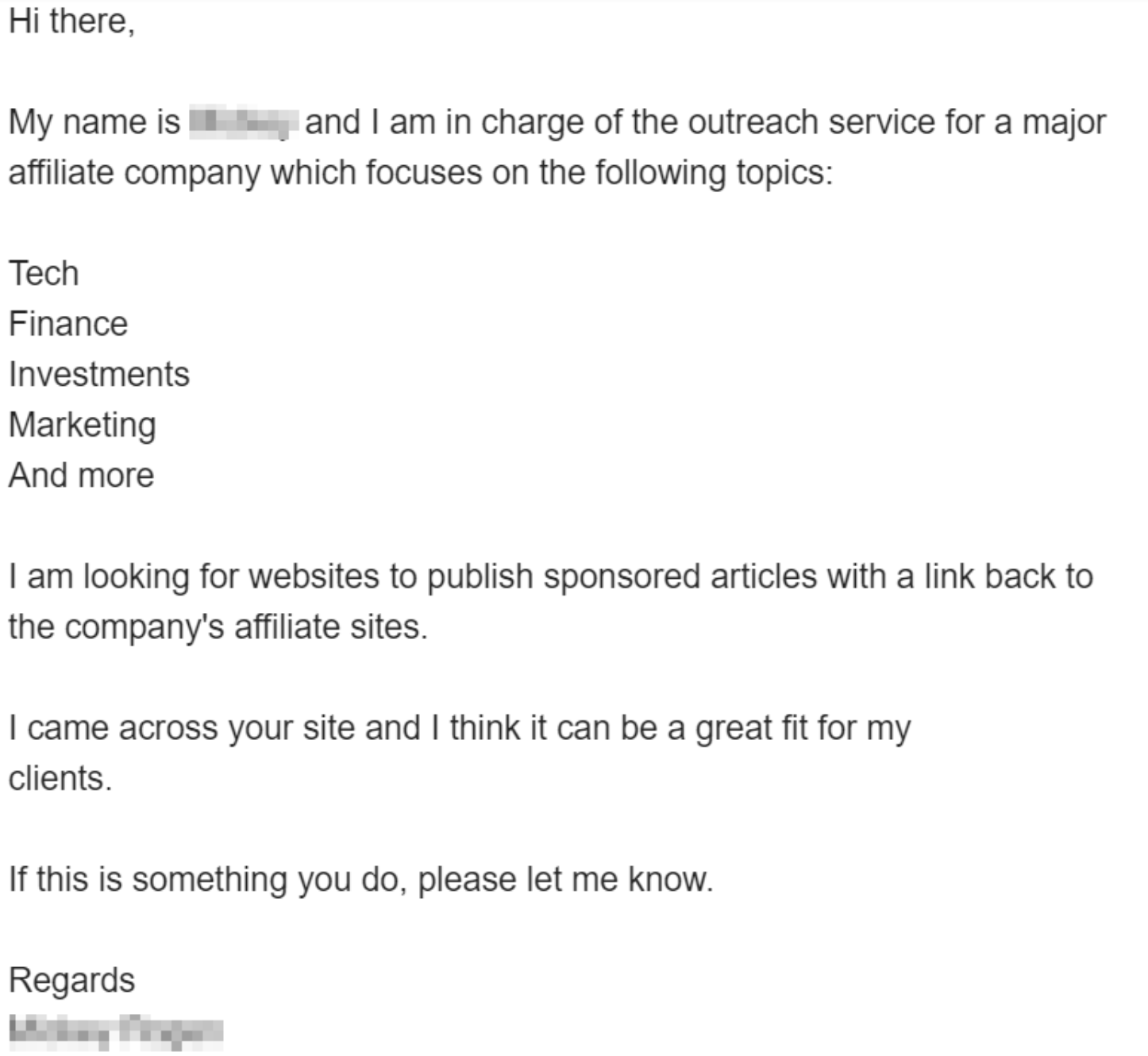
This one’s slightly better than the last, but the issue here is the recommended topics. The site this individual reached out about was not even close to related to the topics they recommended.
Good Outreach #1
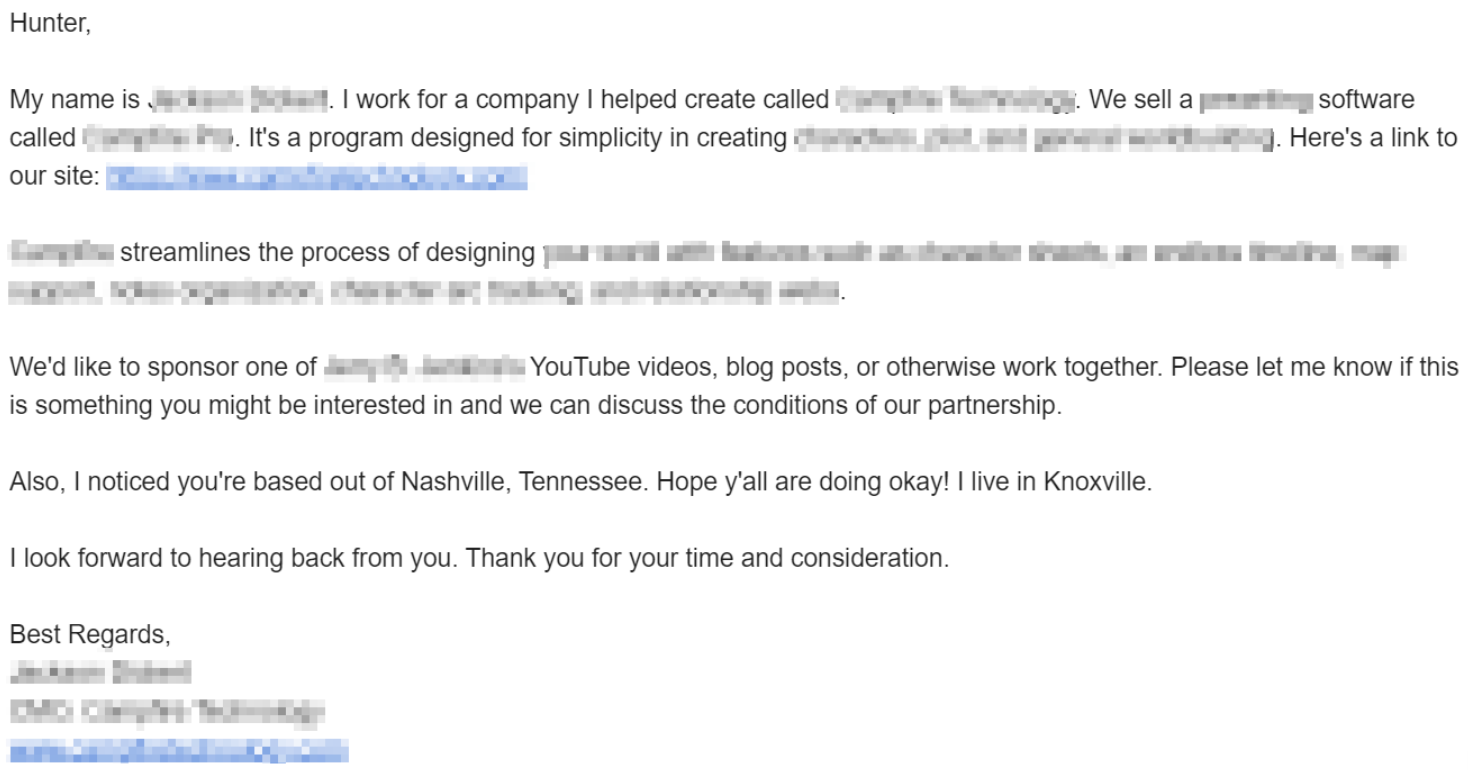
This one does a great job of quickly explaining who they are, what their company does, and how they could help my company (I blurred details to keep the sender anonymous).
You can immediately see this individual gave me his company’s unique selling proposition (which is directly related to the site they reached out about) and offered value (sponsoring content).
They also included several key details that made it obvious that they researched me and my company and took the time to personalize their pitch.
Good Outreach #2

This is a great email that didn’t need much personalization. The sender pitched their company and how they could help my client via link building and content partnerships.
Because they know that my client is trying to grow their organic traffic, this offer is very valuable and garnered a response.
Step 5. Track your campaign and send follow-ups.
The final step in this process is simply doing the work.
The number of emails you need to send per day completely depends on your goals, but I usually send emails out early in the week during afternoon hours (hangry people are way less likely to accept your pitch).
Then, I simply follow up one time 3-5 business days later.
I’ve found a single follow-up to be the best middle ground between not annoying people and reminding people to respond if they’re interested.
You’ll usually get more responses from a follow-up than you will from your initial email.
Luckily, Hunter makes this whole process easy with their Campaigns tool.
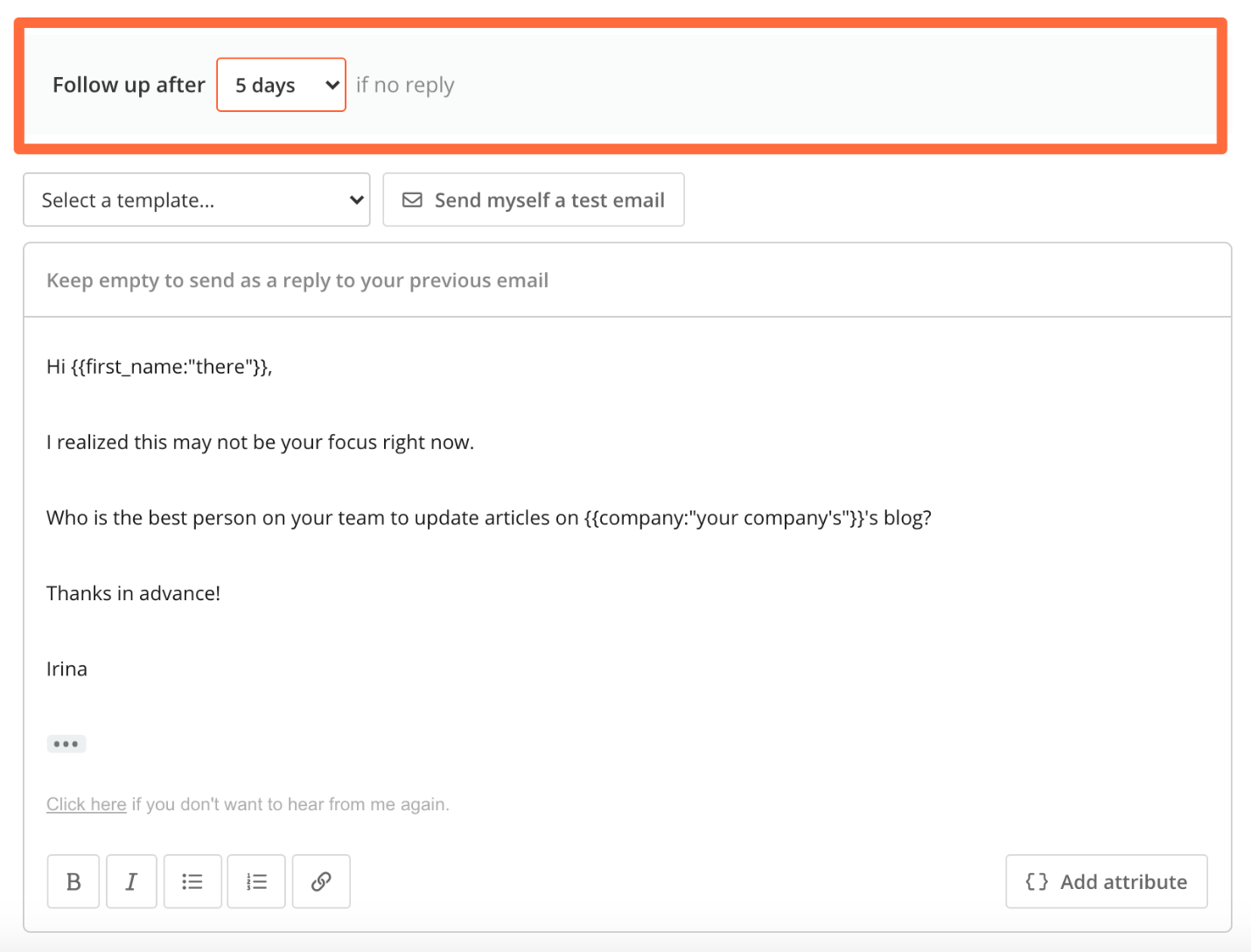
It lets you manage your campaigns straight from your Gmail inbox and can automate follow-ups.
It also provides data on opens, replies, etc. so you can test your subject lines and pitches.
Additional read: How to Write a Follow-Up Email After No Response
Writing a Great Pitch Can Change Your Business
It can be overwhelming to think about spending all this time on a pitch that might not get a response.
That’s a fair concern.
Because regardless of how good your pitch is, there’s always a chance you’ll never hear back.
That’s just life.
But I can promise you that writing highly personalized and valuable pitches will drastically increase your conversion rates.
And one email or article has the potential to change everything.
I’m living proof.
A single cold email back in 2017 ended up generating over $50,000 in revenue for my agency.
Another cold pitch in 2019 ended up getting an article published on a huge marketing site—which ended up ranking in Google and sending me consistent leads.
Spending the time on each pitch is worth it. :)



 Send cold emails with Hunter
Send cold emails with Hunter